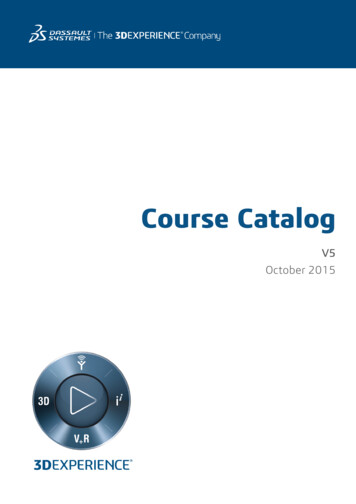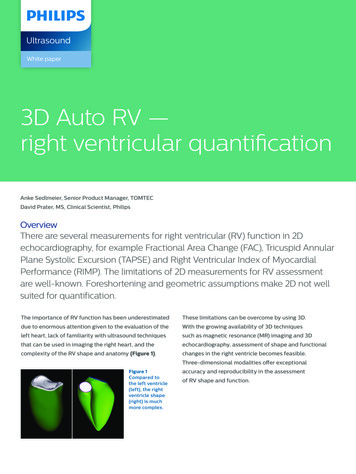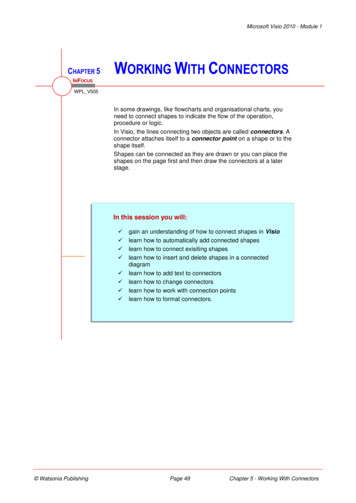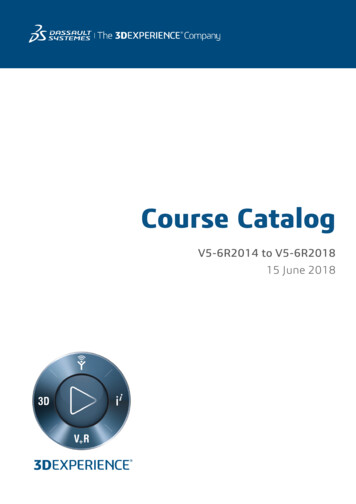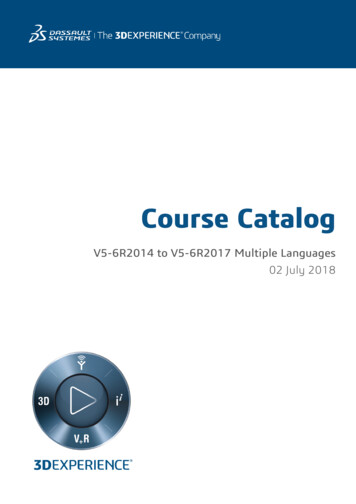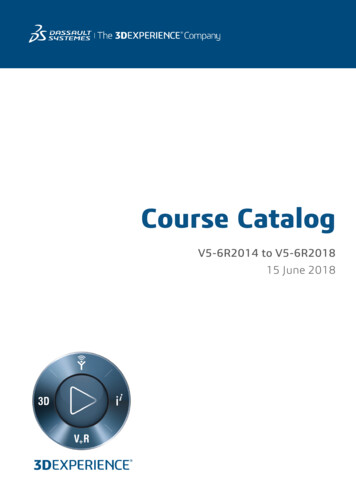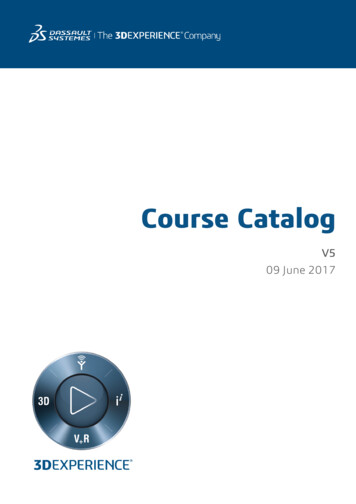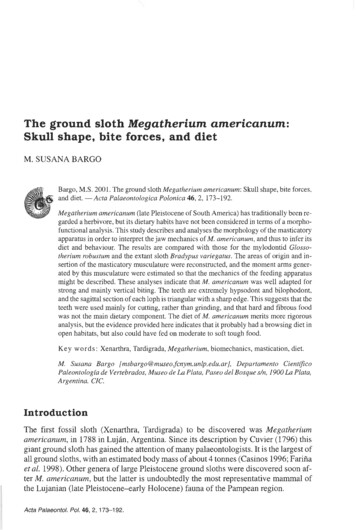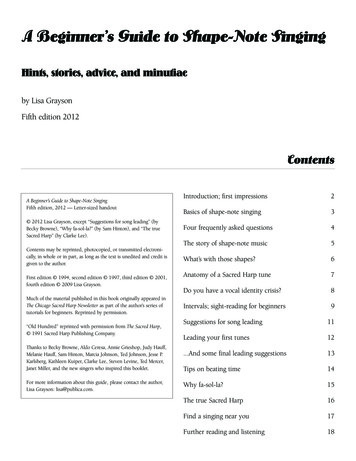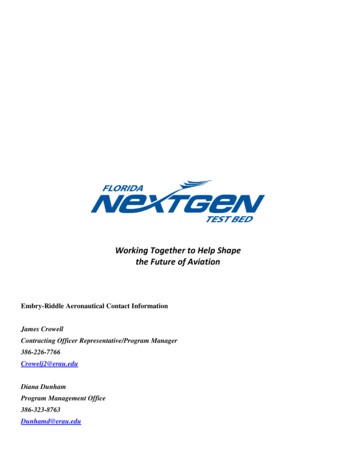
Transcription
Working Together to Help Shapethe Future of AviationEmbry-Riddle Aeronautical Contact InformationJames CrowellContracting Officer Representative/Program Manager386-226-7766Crowelj2@erau.eduDiana DunhamProgram Management Office386-323-8763Dunhamd@erau.edu
IntroductionThe Federal Aviation Administration (FAA) requires an environment for the development of NextGeneration Air Transportation System (NextGen) concepts and technology. Engineering the nation’sfuture air transportation system into reality, NextGen Test Bedswill foster the design, development,integration, evaluation and demonstration of future NextGen goals. All of this is done prior to the launchof full-scale operational capability.Established as a scalable, expandable, cost-effective and repeatable process and architecture, the TestBed sites are envisioned to allow gate-to-gate demonstration of NextGen components. Specifically, thefollowing three sites that host the collective NextGen Test Beds are:1. NASA’s North Texas facility located near the Dallas/Fort Worth International Airport (DFW), TX2. William J. Hughes Technical Center (WJHTC) located near Atlantic City, NJ3. Florida NextGen Test Bed(FTB) located at the Daytona Beach International Airport (DAB), FLCollectively, the NextGen Test Beds will: Provide NextGen rapid integration capability forprototypes Allow end-to-end (multi-domain) demonstrations interaction with existing and arising NAS systems feasibility of new technologies Support demonstration of NextGen components andAct as an open evaluation platforms to analyzeAssist incremental migration of NextGen componentSupport integrated demonstrations to validate largescale modeling and simulation effortsAllow for potential human-in-the-loop demonstrations
The Florida NextGen Test Bed supports the above requirements and provides the followingunique capabilities: A robust platform where integration, rapid prototyping, and demonstration takes place withoutaffecting the air traffic operations in National Airspace System (NAS). Provides access to industry, government, and academia viaa unique development model whichrequires investment from all participating parties. Uses actual NAS systems supplied by industry and government and simulation systems are usedwhere necessary. Systems are linked via the System Wide Information Management (SWIM) and designed tosupport the Flight Data Object (FDO) which are key NextGen enabling technologies.Provides direct access to DAB airport facilities.Provides direct access to Embry-Riddle Aeronautical University (ERAU)resources, includingaircraft, faculty, staff, students, and facilities.
Florida NextGen Test Bed“Working Together to Help Shape the Future of Aviation”The FTB is an FAA initiative to develop a NextGen research and demonstration facility at Daytona Beach.The FTB is developed in order to provide stakeholders with a rapid integration capability for testingOperational Improvements and enablers by leveraging theNASusing prototype capabilities. It utilizes a cost-effectiveand scalable architecture to allow for new growth as theOperational Improvements and enablers evolve. FTBis beingused to integrate and demonstrate NextGen and legacy technologies into existing and plannedenhancements for the NAS.MissionThe mission of the FTB is to provide a microcosm of the NAS, with prototype NextGen capabilities thatare aligned with planned functionality as depicted by the NAS Enterprise Architecture and InfrastructureRoadmaps.The FTB can be used to evaluate concepts, operational research, capabilities, andtechnologies prior to these being funded, implemented, or fielded at a NAS facility. The FTB integratesmultiple flight domains within its facility in order to provide for end-to-end or multi-domaindemonstrations and concept evaluations. It will provide an open platform to help evaluate and examinethe feasibility of new technologies.AccessThrough governance, the FTB will allow access to industry, government, and academic institutionsinterested in the development of NextGen technologies. Partnerships with industry are seen as key to themission of the FTB. The FTB is currently supported by ERAU through an Other Transaction Agreement(OTA) with the FAA to operate the FTBand work with industry in support of NextGen goals.
Facilities and CapabilitiesThe FTB consists of two primary areas: The Integration Suite and the Demonstration Suite. Additionally,theData Center houses the network equipment, rack mounted servers, and other equipment required todrive the operational capabilities in the Integration and Demonstration Suites.Integration SuiteThe Integration Suite, approximately 5,000 square feet, is used to carry out development, test, andintegration efforts for the operational capabilities being evaluated at the FTB. The Integration Suiteincludes the following: Integration Area.This area will allow engineers to work together on development, test,integration, and related activities either separately or collectively.
Video Conference Room.This area will allow for meetings and teleconferences forapproximately twenty people with a high degree of technology. Offices. These will be used for visiting personnel to have temporary private work space while atthe FTB. Data Center. Available for server hosting and telecom. Connectivity to FAA R&D Domainresearch network
Demonstration SuiteThe demonstration suite is at the core of the FTB mission. It is approximately 5,000 square feet andisused to conduct demonstrations of the operational capabilities deployed at the FTB. Designed toaccommodate flexibility and future growth, the suite contains reconfigurable bay areas positioned alongthe periphery to accommodate demonstrating and visualizing different flight domains or operationalareas.Large screen displays throughout the suite enable the audience to view activity on certain monitorswithin the various flight domains, while screens at the front of the suite provide projections ofpresentations, displays or other materials. Seats can be organized in a stadium / theatrical arrangementin order to maximize the audience members’ views of the operational capabilities being demonstrated.
FTB Capabilities and StrengthsWith its location at an operational airport, access to the airport infrastructure, and airport tenants, theFTB provides several important capabilities for NextGen research and demonstrations: Early Stage Concept Evaluation.Rapid Prototype Design.Integration Suite integration does not disrupt Demonstration Suite demonstrations.Ease of access for industry and academia participation.The following sections describe the FTB capabilities and strengths in greater detail.Industry and AcademiaThe FTB has its origins in work conducted by ERAU and members of an Industry Consortium on theIntegrated Airport Initiative (IAI), which began in 2006. The IAI project was aimed at demonstratingemerging concepts and capabilities related toNextGen within the scope of air traffic control,airport, and airline operations. The IAI envisionedan environment where industry partners workedtogether in bringing their skills and technologies intoone facility. The goal was to develop a “microcosm”of the NAS where systems communicated in a“SWIM-like” manner.Leveraging the work performed and contributionsprovided by the IAI, the FAA has since establishedthe FTB as a Government facility while maintaining a
cooperative relationship with the industry members. The team has continued to support the needs of theFAA, while building a solid technological capability. The FTB is envisioned to be an agile research andintegration facility designed to allow government, industry, and academia to showcase their ideas andtechnologies in a NextGen NAS environment. Throughout the development of the FTB, industry hascontributed expertise, NAS technologies, and a myriad of other resources to help make the FTB a success.The industry manufacturers and service providers of existing NAS systems have the specialized expertisenecessary to implement and operate the systems that they have developed and maintained. As ideas andconcepts emerge, these industry members can rapidly develop prototype and integrate capabilities whilemaintaining control of their own intellectual property.As a premier academic and research institution with a focus on aeronautics and aviation, ERAU hasaccess to professors and students involved with many aspects of aviation. These include student andretired controllers, professionals and student pilots who help bring new and innovative concepts andcapabilities to the FTB activities at a relatively low cost. ERAU has a number of labs that support variousaspects of aviation research, including Air Traffic Management (ATM), weather, and Unmanned AircraftSystems (UAS).The human factors department at ERAU offers faculty skill sets to help conductexperiments and Human-In-The Loop (HITL) simulations.Airport, Aircraft, and ServicesThe FTB has a number of advantages afforded to it by its location at the DAB, which is a medium sizeairport environment consisting of a large number of General Aviation (GA) operations. DAB has a class Cairspace with a minimal amount of commercial air traffic, making it easier for the FTB activities not tointerfere with airport operations. The DAB tower and airport authorities have strong ties to ERAU, whichcan help facilitate the FTB activities such as coordinating field operations, installing equipment, orperforming specific air operations. In addition, a jet bridge directly off the FTB allows for easy access toaircraft on the tarmac.The FTB has access to the local ERAU fleetof aircraft, which can participate in livetests and demonstrations of NextGenoperational concepts and capabilities. TheAutomaticDependentSurveillance–Broadcast (ADS-B) equipped fleet presentsthe ability to demonstrate all aspects ofADS-B in an operational environment.
Specific features include: State-wide coverage of 300 nm from ground based transceiver (surface level to FL 600)DAB Airport surface coverageWi-Fi coverage of the airport surface with AeroMACS SystemPrevious and Currently Planned NextGen Research and DemonstrationsDemoActivitiesWx Integrated intoTMA/ERAM(Complete)FYFY08Contract VehicleERAU OTA (Task A)Industry Partners:ERAULockheed-MartinCSCENSCOMosaic ATMInternational Flight DataObject(Complete)FY09FrequentisSaab-SensisERAU OTA (Task D)Industry ed-MartinERAU OTA (Task E)Industry al AtomicsShort DescriptionImprove weather detectionand prediction, pass to TMAvia SWIM-like networkEvaluate SWIM-EnabledCONOPs and controller userinterface concepts for ERAMbased re-planning aroundconvective weather for flightsEn-route to meter fixSystems UsedERAMCARTSTMASDSSVendor Wx dataCWISLab demonstration ofinternational flight dataexchange betweenATOP/ERAM and ATOP/SATLATOPInvestigate ATC and UAS PilotinteractionADS-BDemonstrate use of 4D FlightManagement Systems (FMS)as a control mechanism forprecise/manageable flighttrajectory.Improve UAS pilot traffic /weather “situationalawareness” with ADS-BERAMSWIM like interfaceSingle Thread SATLNVS PrototypeTMAERAMSTARS/CARTS
Surface Exchange of Flight FY09Data Objects(Complete)ERAU OTA (Task F)Industry Partners:ERAULockheed-MartinHarrisExtends flight data object toinclude airport surfaceoperation & demonstratecollaboration and infoexchangeASDE-XSurface Decision SupportToolsSaab-SensisMosaic ATMFrequentis4-D FMS(Follow-On)(Complete)FY09/10/11/12ENSCONATS UKERAU OTA (Task G)Industry Partners:ERAUGE AviationLMCOOceanic In-Flight Advisory FY09/10 ERAU OTA (Task H)Operational Trial/11Industry elCharacterizing theperformance of advanced FMScapabilities in relation tofuture Air Traffic RequiredTime of Arrival (RTA)conceptsFollow-on include trajectorysync between ERAM and FMS.Work is in collaboration withCLEEN program.Plan an operational trial thatmakes available the OceanicIn-flight Advisory tool to AOCsvia SWIM-like infrastructureSaab-SensisAircraft ArrivalManagement System(AAMS)(Follow-On)FY10/11/12(Complete)Flight Data Objects Phase3(Follow-On)(Complete)HarrisENSCOERAU OTA (Task J)Industry Partners:ERAUATH GroupFY11/12ERAU OTA (Task K)Industry ContributionIndustry Partners:ERAULockheed-MartinHarrisCollect data and determinepotential benefit of using anAOC based metering tool andprovide analysis in support offuture NAS enhancementstowards the implementationof point in space metering inthe NASDevelop a Preliminary FDOBenefits AnalysisInitiate the Demonstrationengineering analysisEstablish Demonstrationscenarios data elements,procedures, stakeholders,engineering needs andscheduling.TMAGE FMSERAMATOPSATLOceanic In-flight AdvisorytoolAAMS Metering ToolAOC Partner systemsATOPERAMSWIM like interfaceSingle Thread SATL
Standard ColorPalette for Air TrafficDisplaysFY10(Complete)NNEW & 4DWeather Cube(Follow-On)ERAU OTA (Task L)Industry ContributionIndustry Partners:FY11/12(Complete)ERAUERAU OTA (Task N)Industry Partners:ERAUDefine a set of colors to beused to uniquely codeinformation on computerdriven Air Traffic Displays tobe used in the Next GenerationAir Transportation System(NextGen).Investigate whetherintegration and republicationcapabilitiesERAMATOPCARTSASDE-XNNEW WeatherDistribution Server /ClientLockheed-MartinAircraft Access to SWIM(In Progress)FY12/13HarrisENSCOERAU OTA (Task O)Industry Partners:ERAUHarris Corp.HoneywellDevelop a platform leveraging SWIM (DEX)(NEMS)the FTB infrastructure toData Messaging Servicedemonstrate the use of an EFBElectronic Flight Bagto access SWIM information.AeroMacsAerobaunRockwell CollinsNetJetsVirgin AmericaAutomation Convergence(Complete)Other carriersFY12/13 ERAU OTA (Task P)Industry Partners:ERAULMCOAirborne Execution ofFlow Strategies(Follow On)(In Progress)HarrisMosaic ATMFY12/14 ERAU OTA (Task Q)Industry Partners:ERAULMCOMetronDemonstrate the technical ERAMand operational feasibility NEMSof extending Flight DataSDSSservices from the EnRouteautomation system toprovide an infrastructure toTRACON and Towerfacilities.Demonstrate the technicaland operational feasibilityof allowing airlines toprovide priorities to theirfleet to be managed byTraffic Based FlowManagement.TBFM
Mini Global(In Progress)FY13/14 ERAU OTA (Task R)Industry Partners:ERAULMCOHarrisMosaic ATMNATSInt’l Partners TBDMini Global will demonstratethe applicability of the globalexchange models for Flight,Aeronautical and Weatherinformation.MG will show how the FAA,International ANSPs and flightoperators, in both the Pacificand Atlantic regions, are ableto share common informationto: Improve collaborativedecision making (CDM) Improve air trafficmanagement (ATM) Promote TGFNCROV DexMini Global CloudInt’l Systems
RoadmapNextGen Roadmap Purposes of the roadmap: Roadmap based on FAA NextGendocuments and FTB projects Communication tool to illustrate NextGeninitiatives and their relationship of FTBTasks Analysis tool to help identify gaps inNextGen operational initiatives and currentor planned FTB Tasks
Key for Florida NextGen Test Bed TasksTask H – Oceanic Conflict Advisory Trial (OCAT) – Phase 3Task L(2) Color PaletteTask M3 – FTB Core SWIM InfrastructureTask O – Aircraft Access to Swim (AAtS) – ResearchTask O – Aircraft Access to Swim (AAtS) - Phase 2 - Team #1Task O – Aircraft Access to Swim (AAtS) - Phase 2 - Team #2Task Q – AEFS Phase 2 (Notional)Task R – Mini Global – Risk Mitigation Demo (Yr1)Task R – Mini Global – Phase II (2014 - 2015)Task S – Air Traffic Control Facilities SurveyFrequently Asked QuestionsHow have Florida NextGen Test Bed activities furthered NextGen?The Test Bed has furthered NextGen activities by:1. Acting as a platform to conduct NextGen technology and concept evaluations and demonstrations2. Allowing FAA to understand prospects of the early-stage concept or technology for implementation andunderstand potential benefits and risks3. Helping FAA make decisions on potential operational implementationsWhat are some specific examples as to how Florida NextGen Test Bed activities have helped the FAA’sNextGen decision making?The Test Bed allowed for concept demonstrations and evaluations that have/will lead to NextGen implementationdecision making in the following areas:1. Unmanned Arial Systems (UAS) concept demonstrations2. 4-D Flight Management System (FMS) concept demonstrations3.Flight Data Object (FDO) concept demonstrations4. Aircraft Arrival Management System (AAMS) concept demonstrations5. Oceanic Trajectory Based Operations (TBO) concept demonstrations
How haveFlorida NextGen Test Bed activities supported the RTCA Taskforce 5 recommendations?The Test Bed supports RTCA Task Force 5 recommendations by enabling demonstrations & evaluations in theareas of:1. Convective weather integration with TMA/TBFM and ERAM to improve flow metering during convectiveweather events. This supports the following Task Force 5 recommendations:a. Cruise Segment Recommendation: Expand use of Time Based Meteringb. Integrated ATM Recommendation: Improve CATM automation to negotiate user-preferredroutes and alternative trajectories2. Oceanic Conflict Advisory Tool (OCAT) development with Airline Operations Center (AOC) involvement.This supports the following Task Force 5 recommendations:a. Integrated ATM Recommendation: Facilitate integrated system-wide approach(CDM/TFM/ATC)b. Integrated ATM Recommendation: Improve CATM automation to negotiate user-preferredroutes and alternative trajectories3. Surface Flight Data Object (FDO) development. This supports the following Task Force 5recommendations:a. Surface Recommendation: Establish TFM common operational picture & interoperabilitystandards for sharing surface data among AOC & FAAb. Surface Recommendation: Situational Awareness Phase 2 – integrated airport movementmanagement decision support tools, standards, processes4. Network Enabled Operations (NEO) Spiral 2 demonstration. Supports Task Force 5 recommendation:a. Cruise Segment Recommendation: Special Activity Airspace (SAA) real-time status andscheduling
Generation Air Transportation System (NextGen) concepts and technology. Engineering the nation's future air transportation system into reality, NextGen Test Bedswill foster the design, development, integration, evaluation and demonstration of future NextGen goals. All of this is done prior to the launch of full-scale operational capability.
